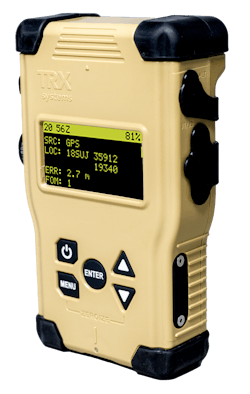Army picks TRX Systems for handheld GPS-denied positioning, navigation, and timing (PNT) for infantry
ABERDEEN PROVING GROUND, Md. – U.S. Army navigation and guidance experts needed handheld positioning, navigation, and timing (PNT) devices that enable infantry soldiers to fight where GPS signals are not available. They found their solution from TRX Systems Inc. in Greenbelt, Md.
Officials of the Army Contracting Command at Aberdeen Proving Ground, Md., announced a $402.5 million seven-year contract to TRX last month for Dismounted Assured Positioning, Navigation, and Timing System (DAPS) Generation II units.
DAPS is replacing the Army’s legacy Defense Advanced GPS Receiver (DAGR) for infantry soldiers. It gives Army forces access to trusted PNT where Global Positioning System (GPS) satellite navigation signals may be limited or denied.
Unlike the DAGR, DAPS incorporates a military code receiver, and its non-GPS capabilities give the user PNT information from several different sources.
Units equipped with DAPS will use their trusted PNT information to operate in GPS-denied conditions like dense vegetation, built-up urban and mountainous terrain, and in the presence of electromagnetic interference or enemy electronic warfare (EW) jamming and spoofing of GPS signals.
DAPS PNT information helps Army commanders positioning their forces; navigate; communicate on tactical networks; and gain situational awareness, surveillance, targeting; and engagement capabilities.
The DAPS GEN II has two experimental predecessors: the DAPS GEN 1.0 from Integrated Solutions for Systems Inc. in Auburn, Ala., and the DAPS GEN 1.2 from TRX Systems.
DAPS GEN 1.0 has a boot module to help soldiers maintain PNT based on soldier movements, and interfaces with soldiers via the Nett Warrior End User Device (EUD). DAPS GEN 1.2, meanwhile, has an internal rechargeable battery, internal inertial measurement unit, and alternative satellite reception.
DAPS GEN II is an improved version of DAPS GEN 1.2 with an external, detachable rechargeable battery, redesigned screen and soldier interface, and improved PNT data-fusion capability. In June 2022 the Army chose TRX as the DAPS GEN II prime contractor, and began field and lab testing.
On this contract TRX will do the work at locations to be determined with each order, and should be finished by March 2030. For more information contact TRX Systems online at www.trxsystems.com, or the Army Contracting Command-Aberdeen at https://acc.army.mil/contractingcenters/acc-apg/.
About the Author
John Keller
Editor-in-Chief
John Keller is the Editor-in-Chief, Military & Aerospace Electronics Magazine--provides extensive coverage and analysis of enabling electronics and optoelectronic technologies in military, space and commercial aviation applications. John has been a member of the Military & Aerospace Electronics staff since 1989 and chief editor since 1995.
